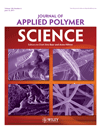Encapsulation of disperse dye by phase separation technique using poly(styrene-maleic acid)
Abstract
C.I. disperse dye blue 60 was encapsulated by poly(styrene-maleic acid) using phase separation technique, followed by the preparation of the encapsulated disperse dye dispersion. The effects of process conditions on particle size of the dispersion were investigated. The results showed that the particle size of the encapsulated disperse dye dispersion was small, and the stability was excellent when mass ratio of poly(styrene-maleic acid) to disperse dye (Rp/d), dropping speed of phase separation agent (Ds), disperse dye content in dispersion (Cd), and dispersing time (Dt) were about 20%, 7 mL/min, 5–7.5%, and 1.5 h, respectively. Transmission electron microscope (TEM), zeta potentials, and contact angle indicated that C.I. disperse dye blue 60 was successfully encapsulated by poly(styrene-maleic acid). © 2011 Wiley Periodicals, Inc. J Appl Polym Sci, 2011




